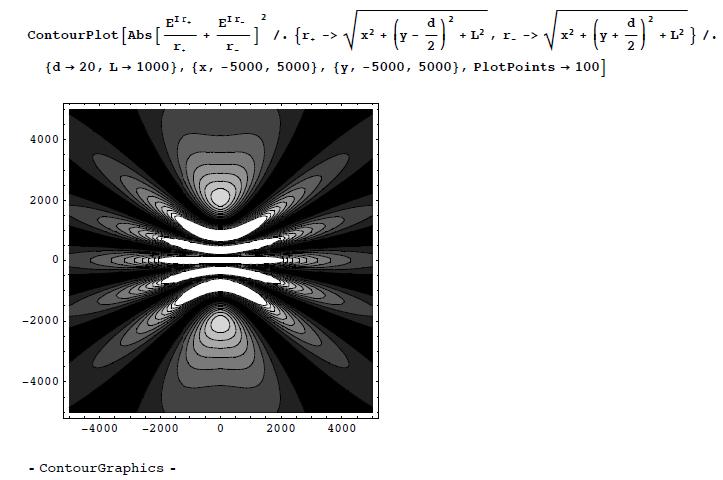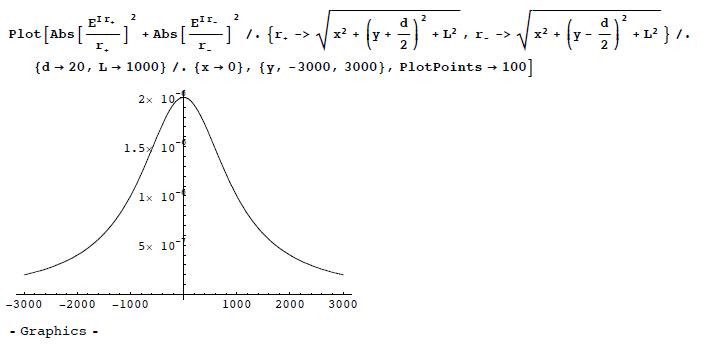Phy5645/Double pinhole experiment: Difference between revisions
No edit summary |
No edit summary |
||
| (5 intermediate revisions by the same user not shown) | |||
| Line 1: | Line 1: | ||
(a) As stated in the problem, we assume that the denominators are approximately the same between the two waves. This is justified because the corrections are only on the order of <math>d/L\!</math>, and we are interested in the case where <math>d<<L\!</math>. We require that the numerators have the same phase, namely <math>kr_{+}-kr_{-}=2\pi n\!</math>. We expand the LHS with respect to <math>d\!</math>, | |||
:<math> | :<math> | ||
| Line 63: | Line 16: | ||
(b) Let us | (b) Let us work in units in which <math>k = 1</math>; that is, we measure all lengths in units of <math>1/k\!</math>. We then set <math>d = 20\!</math> and <math>L = 1000\!</math>. Here is the interference pattern. We first plot the pattern along the <math>y\!</math> axis <math>(x = 0):\!</math> | ||
| Line 69: | Line 22: | ||
(c) | (c) Using the same parameters as before, we now plot the pattern on the <math>xy\!</math> plane: | ||
[[Image:Double_pinhole_plot_2.JPG]] | [[Image:Double_pinhole_plot_2.JPG]] | ||
(d) | (d) We use the same parameters as in (b) and (c). First, we plot the pattern along the <math>y\!</math> axis <math>(x = 0):\!</math> | ||
[[Image:Double_pinhole_plot_3.JPG]] | [[Image:Double_pinhole_plot_3.JPG]] | ||
We now plot the pattern on the plane: | |||
[[Image:Double_pinhole_plot_4.JPG]] | [[Image:Double_pinhole_plot_4.JPG]] | ||
The main difference is the absence of the interference pattern. | |||
Back to [[Stern-Gerlach Experiment#Problem|Stern-Gerlach Experiment]] | |||
Latest revision as of 13:20, 18 January 2014
(a) As stated in the problem, we assume that the denominators are approximately the same between the two waves. This is justified because the corrections are only on the order of , and we are interested in the case where . We require that the numerators have the same phase, namely . We expand the LHS with respect to ,
Therefore,
and hence
(b) Let us work in units in which ; that is, we measure all lengths in units of . We then set and . Here is the interference pattern. We first plot the pattern along the axis
(c) Using the same parameters as before, we now plot the pattern on the plane:
(d) We use the same parameters as in (b) and (c). First, we plot the pattern along the axis
We now plot the pattern on the plane:
The main difference is the absence of the interference pattern.
Back to Stern-Gerlach Experiment

















